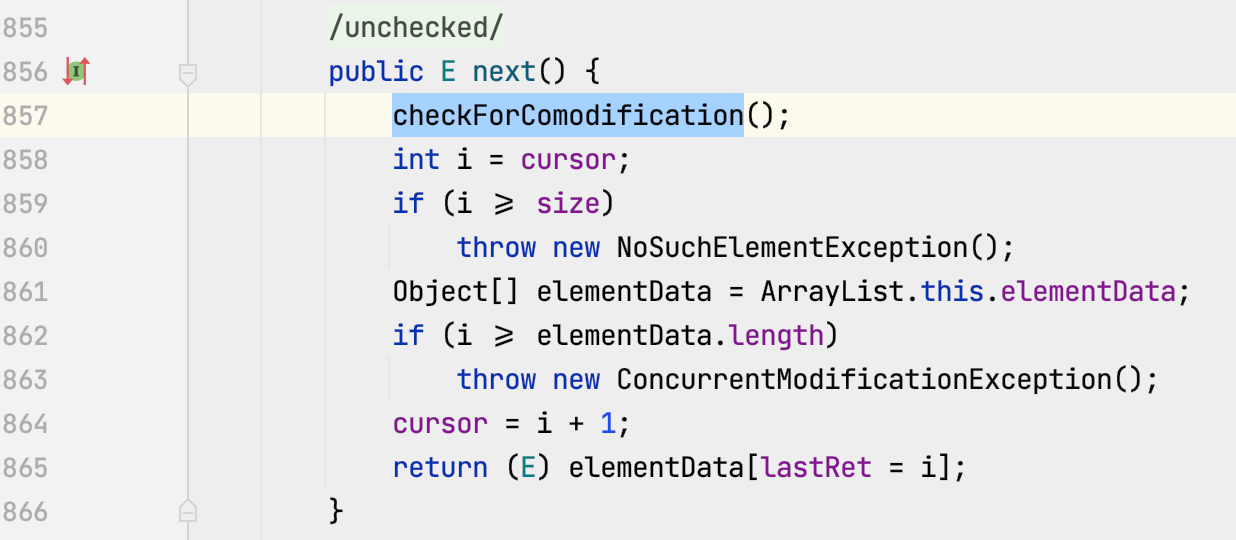
既然是绕过迭代器遍历时的数据修改异常,那么有必要先看一下是什么样的异常。如果在集合的迭代器遍历时尝试更新集合中的数据,比如像下面这样,我想输出 Hello,World,Java,迭代时却发现多了一个 C++ 元素,如果直接删除掉的话。
List<String> list = new ArrayList<>(); Collections.addAll(list, "Hello", "World", "C++", "Java"); // 我想输出 Hello,World,Java,迭代时发现多一个 C++,所以直接删除掉。 Iterator iterator = list.iterator(); System.out.println(iterator.next()); System.out.println(iterator.next()); list.remove("C++"); System.out.println(iterator.next());那么我想你一定会遇到一个异常 ConcurrentModificationExceptio 。
Hello World java.util.ConcurrentModificationException at java.util.ArrayList$Itr.checkForComodification(ArrayList.java:907) at java.util.ArrayList$Itr.next(ArrayList.java:857) at com.wdbyte.lab.jdk.ModCountDemo.updateCollections(ModCountDemo.java:26)这个异常在刚开始学习 Java 或者使用其他的非线程安全的集合过程中可能都有遇到过。导致这个报错出现的原因就和我们操作的一样,对于某些集合,不建议在遍历时进行数据修改,因为这样会数据出现不确定性。
那么如何绕过这个错误呢?这篇文章中脑洞大开的三种方式一定不会让你失望。
异常原因这不是一篇源码分析的文章,但是为了介绍绕过这个异常出现的原因,还是要提一下的,已经知道的同学可以直接跳过。
根据上面的报错,可以追踪到报错位置 ArrayList.java 的 857 行和 907 行,追踪源码可以发现在迭代器的 next 方法的第一行,调用了 checkForComodification() 方法。

而这个方法直接进行了一个把变量 modCount 和 expectedModCount 进行了对比,如果不一致就会抛出来 ConcurrentModificationException 异常。
final void checkForComodification() { if (modCount != expectedModCount) throw new ConcurrentModificationException(); }那么 modCount 这个变量存储的是什么信息呢?
/** * The number of times this list has been <i>structurally modified</i>. * Structural modifications are those that change the size of the * list, or otherwise perturb it in such a fashion that iterations in * progress may yield incorrect results. * * <p>This field is used by the iterator and list iterator implementation * returned by the {@code iterator} and {@code listIterator} methods. * If the value of this field changes unexpectedly, the iterator (or list * iterator) will throw a {@code ConcurrentModificationException} in * response to the {@code next}, {@code remove}, {@code previous}, * {@code set} or {@code add} operations. This provides * <i>fail-fast</i> behavior, rather than non-deterministic behavior in * the face of concurrent modification during iteration. * * <p><b>Use of this field by subclasses is optional.</b> If a subclass * wishes to provide fail-fast iterators (and list iterators), then it * merely has to increment this field in its {@code add(int, E)} and * {@code remove(int)} methods (and any other methods that it overrides * that result in structural modifications to the list). A single call to * {@code add(int, E)} or {@code remove(int)} must add no more than * one to this field, or the iterators (and list iterators) will throw * bogus {@code ConcurrentModificationExceptions}. If an implementation * does not wish to provide fail-fast iterators, this field may be * ignored. */ protected transient int modCount = 0;直接看源码注释吧,直接翻译一下意思就是说 modCount 数值记录的是列表的结构被修改的次数,结构修改是指那些改变列表大小的修改,或者以某种方式扰乱列表,从而使得正在进行的迭代可能产生不正确的结果。同时也指出了这个字段通常会在迭代器 iterator 和 listIterator 返回的结果中使用,如果 modCount 和预期的值不一样,会抛出 ConcurrentModificationException 异常。
而上面与 modCount 进行对比的字段 expectedModCount 的值,其实是在创建迭代器时,从 modCount 获取的值。如果列表结构没有被修改过,那么两者的值应该是一致的。
绕过方式一:40 多亿次循环绕过上面分析了异常产生的位置和原因,是因为 modCount 的当前值和创建迭代器时的值有所变化。所以第一种思路很简单,我们只要能让两者的值一致就可以了。在源码 int modCount = 0; 中可以看到 modCount 的数据类型是 INT ,既然是 INT ,就是有数据范围,每次更新列表结构 modCount 都会增1,那么是不是可以增加到 INT 数据类型的值的最大值溢出到负数,再继续增加直到变回原来的值呢?如果可以这样,首先要有一种操作可以在更新列表结构的同时不修改数据。为此翻阅了源码寻找这样的方法。还真的存在这样的方法。
public void trimToSize() { modCount++; if (size < elementData.length) { elementData = (size == 0) ? EMPTY_ELEMENTDATA : Arrays.copyOf(elementData, size); } }
